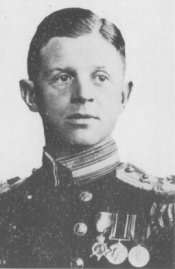Bernard Warburton-Lee
Captain Bernard Armitage Warburton Warburton-Lee VC (13 September 1895 – 10 April 1940) was a Welsh recipient of the Victoria Cross, the highest award for gallantry in the face of the enemy that can be awarded to British and Commonwealth forces.
Bernard Armitage Warburton Warburton-Lee | |
|---|---|
 | |
| Born | 13 September 1895 Broad Oak, Wrexham, Wales |
| Died | 10 April 1940 (aged 44) HMS Hardy, Ofotfjord, Norway |
| Buried | Ballangen New Cemetery, Norway |
| Allegiance | |
| Service/ | |
| Years of service | 1908–1940 |
| Rank | Captain |
| Commands held | HMS Tuscan (1924–25) HMS Walpole (1926–27) HMS Vanessa (1928–30) HMS Bryony (1933–34) HMS Witch (1934–36) Flag Captain, HMS Effingham (1938–39) HMS Hardy (1939–40) 2nd Destroyer Flotilla (1939–40) |
| Battles/wars | Second World War |
| Awards | Victoria Cross Mentioned in Despatches War Cross (Norway)[1] |
Military career
He attended the British Army's Staff College, Camberley from 1931 to 1932, where Brian Horrocks, later a lieutenant general and an outstanding corps commander, was among his fellow students. Horrocks wrote that it "was the practice for a naval officer to join the course for the final year, and our sailor turned out to be that remarkable all-rounder Warburton-Lee who won the V.C. at Narvik".[2]
Spanish Civil War
In 1936 due to the outbreak of the Spanish Civil War and because there was fear of social unrest in the naval station, the Foreign Office in London organized a ship to repatriate the remaining British citizens and on 22 July 1936 HMS Witch, captained by B.A. Warburton-Lee, departed from Ferrol in northwestern Spain for Britain.[3]
Second World War
Warburton-Lee was 44 years old and a captain in the Royal Navy when the following action took place during the Second World War, for which he was awarded the VC.
On 10 April 1940 in Ofotfjord, Narvik, Norway, in the First Battle of Narvik Captain Warburton-Lee of HMS Hardy commanded the British 2nd Destroyer Flotilla, consisting of five destroyers (HMS Hardy, Havock, Hostile, Hotspur and Hunter), in a surprise attack on German destroyers and merchant ships in a blinding snowstorm. This attack was successful, but was almost immediately followed by an engagement with five more German destroyers, during which Captain Warburton-Lee was mortally wounded by a shell which hit Hardy's bridge. For his exploits in this engagement he was posthumously awarded Britain's highest decoration for valour in combat, the Victoria Cross. During the Second World War, only 23 Victoria Crosses were awarded to members of the Royal Navy and Royal Naval Reserve, of whom only approximately 11 survived. In 1942 he was also, posthumously, awarded the Norwegian War Cross.[4]
VC citation
Bernard Warburton-Lee's VC citation reads as follows:
For gallantry, enterprise and daring in command of the force engaged in the First Battle of Narvik, on 10th April, 1940. On being ordered to carry out an attack on Narvik, Captain Warburton-Lee learned that the enemy was holding the place in much greater force than had been thought. He signalled to the Admiralty that six German destroyers and one submarine were there, that the channel might be mined, and that he intended to attack at dawn. The Admiralty replied that he alone could judge whether to attack, and that whatever decision he made would have full support. Captain Warburton led his flotilla of five destroyers up the fjord in heavy snow-storms, arriving off Narvik just after daybreak. He took the enemy completely by surprise and made three successful attacks on warships and merchantmen in the harbour. As the flotilla withdrew, five enemy destroyers of superior gunpower were encountered and engaged. The captain was mortally wounded by a shell which hit the bridge of H.M.S. Hardy. His last signal was "Continue to engage the enemy".
This was the first VC to be gazetted in the Second World War.
Personal life
On 9 October 1924, Lt. Warburton-Lee married Elizabeth Campbell Swinton, the daughter of Capt. George Swinton of Kimmerghame (see Clan Swinton).
References
- Royal Navy Officers 1939–1945
- Horrocks, pps. 69−70
- BBC history
- "No. 35743". The London Gazette (Supplement). 13 October 1942. p. 4450.
Bibliography
- British VCs of World War 2 (John Laffin, 1997)
- Monuments to Courage (David Harvey, 1999)
- The Register of the Victoria Cross (This England, 1997)
- Horrocks, Sir Brian (1960). A Full Life. Barnsley: Leo Cooper. ISBN 0-85052-144-0.